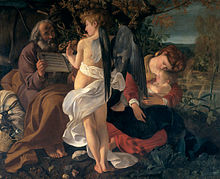Palazzo Doria-Pamphilj
The Palazzo Doria-Pamphilj is a palace in Rome . It is located between Via del Corso , Piazza del Collegio Romano, Via della Gatta and Via del Plebiscito.
history
The property originally belonged to the Della Rovere family and then came to the Aldobrandini family . In 1647 it came through marriage to the Pamphilj family and in 1671 again through marriage to the Genoa family Doria , which enlarged it and made it the largest inhabited palace in Rome. Larger than some royal castles in Europe, it is still the residence of the noble family and houses a valuable collection of paintings and art objects, the so-called Galleria Doria Pamphilj , which is open to the public.
The story of the Doria-Pamphilj is the result of various alliances between noble families from all parts of Italy. The best known members of the family include the Admiral Andrea Doria and the Pope Innocent X. Pamphilj. His famous portrait, painted by Velázquez , hangs in the palace. It was commissioned in the Holy Year 1650 by Olimpia Maidalchini , the Pope's sister-in-law, who was his close confidante and advisor and, in the opinion of some, supposedly his lover. In 1927 a small room was created exclusively dedicated to Pope Innocent X, where the picture of Velázquez and a portrait bust of Gian Lorenzo Bernini are exhibited.
The son of Olimpia Maidalchini, Camillo Pamphilj, opposed his powerful mother and renounced the call to cardinal through his uncle, the Pope, in order to marry the widow Olimpia Borghese . Born Aldobrandini, she brought the Palazzo Aldobrandini into the Pamphilj family. After a period of exile in the Campagna Romana in order to avoid confrontation with the Pope and Olimpia Maidalchini, the couple took up permanent residence in the Palazzo Aldobrandini, which Camillo generously expanded from 1654. Neighboring houses and a monastery were bought and demolished.
Antonio Del Grande was commissioned as the architect for the project . The facade facing Via del Corso was realized by Gabriele Valvassori 1730–1735.
After the death of Camillo Pamphilj in 1666, the building was continued by his sons Giovanni Battista, the heir and Cardinal Benedetto Pamphilj . The collection of paintings and the chapel, which was built according to the plans of Carlo Fontana , go back to the latter, known for his patronage .
One of Camillos and Olimpia's daughters, Anna Pamphilj, married the Genoese aristocrat Giovanni Andrea III Doria- Landi in 1671. Their descendants inherited the palace, while the Roman branch of the Pamphilj family died out in 1760. In 1763 Prince Andrea IV adopted the name Doria – Pamphilj – Landi, which is still valid today. In 1767 the ceilings of the representative rooms were frescoed in the baroque style, as they can still be seen today. Columns were moved from the church of San Salvatore delle Coppelle to the palace during the structural changes in 1782.
The family died out in 2000 with Donna Orietta, the only daughter of Prince Filippo Doria-Pamphilj-Landi. Donna Orietta and her English husband Don Frank did a lot for the restoration of the collection and the palace. After her departure, the management of the collection was taken over by her adoptive children of English origin, Don Jonathan and Donna Gesine Pogson Doria Pamphilj, who also live in the palace.

The Galleria Doria Pamphilj contains, in addition to the baroque halls with furniture and interior decorations, one of the most important private art collections in Rome with numerous paintings by old masters, etc. a. by Raffael , Lorenzo Lotto , Parmigianino , Jacopo Bassano , Tintoretto , Caravaggio , Memling , Jan van Scorel , Jan Brueghel the Elder Ä. , Annibale Carracci , Domenichino , Guercino , Domenico Fetti , Mattia Preti , Jusepe de Ribera , Claude Lorrain , Poussin , Gaspar van Wittel . The special attraction of the picture collection lies in the historical hanging in original showrooms from the 17th and 18th centuries. Antique and baroque sculptures and busts can also be seen.
The palace is not to be confused with the Palazzo Pamphilj , which is also located in Rome on Piazza Navona . Another Palazzo Doria-Pamphilj is in Valmontone in the metropolitan city of Rome .
Poussin Hall ( sala del Pussino )
Web links
- official family website (English and Italian)
Individual evidence
- ^ Mauro Lucentini, La grande guida di Roma , Newton & Compton, Rome 1999, ISBN 88-8289-053-8
- ↑ L. Montalto, Un mecenate in Roma barocca: il cardinal Benedetto Pamphili (1653-1730) , [[Sansoni (publisher) |]], Florence 1955th
Coordinates: 41 ° 53 ′ 52.1 ″ N , 12 ° 28 ′ 53 ″ E









